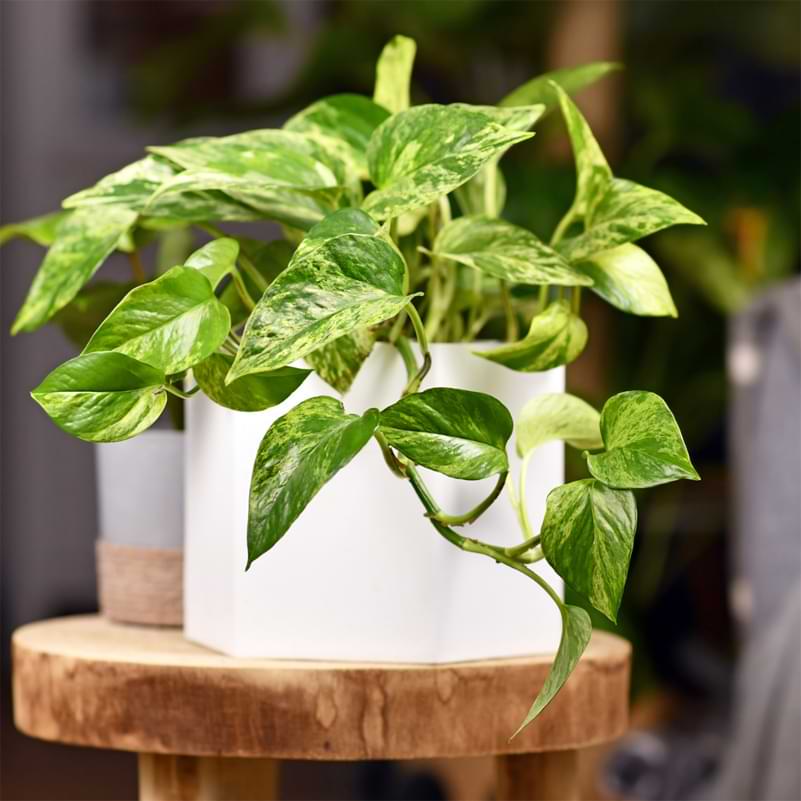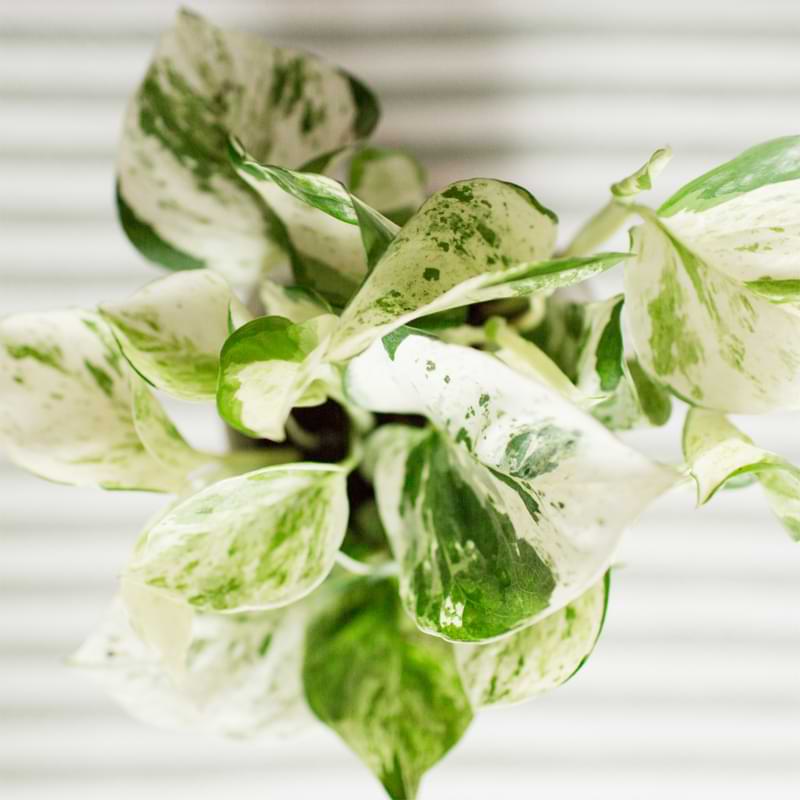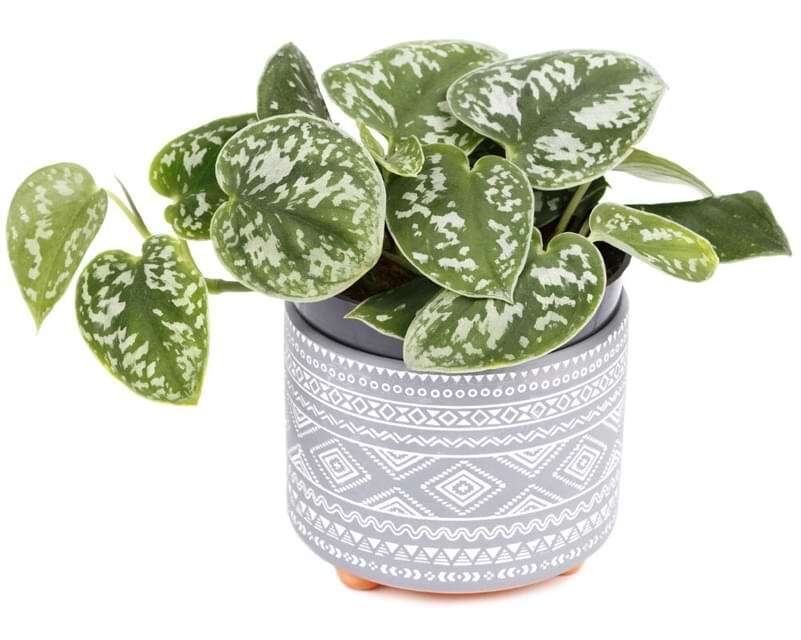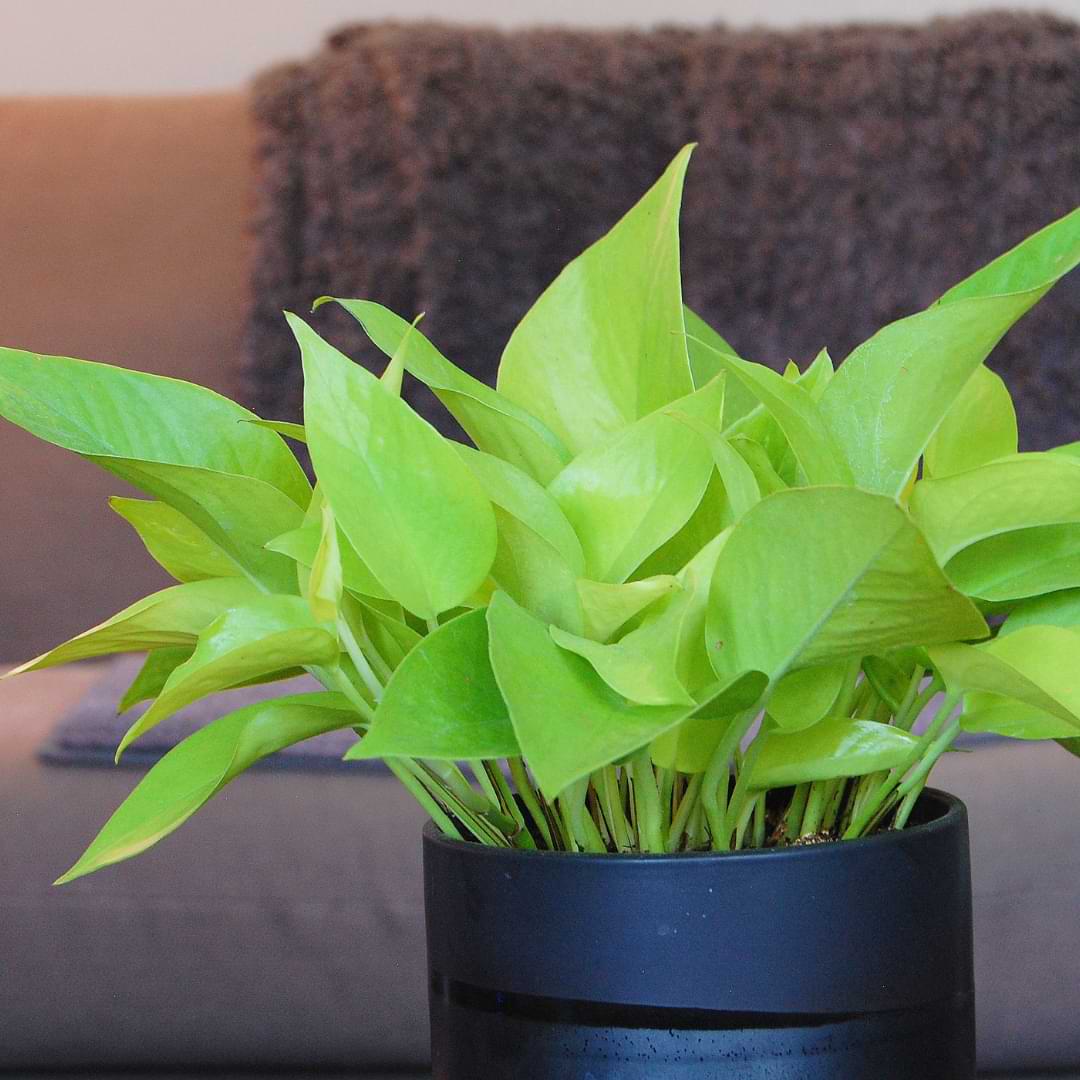Around here, we’re big fans of pothos varieties, and one of our all-time favorites is the neon pothos. This bright chartreuse pothos variety is famous for its neon-green leaves, and, luckily, neon pothos care is also very easy. If you’re looking for an eye-catching plant that will brighten up your space without a lot of work, the search is over!
Table of Contents
Neon Pothos Care
If you’ve cared for pothos plants before, you’ll have no trouble keeping your neon pothos bright and beautiful. There are a few differences in care for this variety, but ultimately, this one is an easy keeper.
Here’s how to grow the healthiest and most striking neon pothos possible!
Soil and Potting
This plant doesn’t like to sit in water, so make sure to use a light, well-aerated soil mix that drains quickly.
Cactus soil can work in a pinch, but if you’ve got the time and desire to make a DIY mix, we love this aroid soil recipe from Kaylee Ellen on YouTube.
In a large bowl, mix together:
- 5 parts orchid bark
- 4 parts coir
- 5 parts perlite
- 2 parts activated charcoal
- 2 parts worm castings
If you want a high-quality soil without all the extra work or extra ingredients lying around, I highly recommend our Monstera Potting Mix for neon pothos. Though this soil was designed specifically for monsteras, I use it for all my aroids, including pothos varieties, and they love it!
This soil is an ideal blend of drainage and water retention with the perfect nutrient balance and pH levels for aroids like neon pothos. The orchid bark also keeps it well-aerated so it won’t compact and require repotting before your plant is actually ready to go up a pot size.
Give it a try!
When choosing a pot for your neon pothos, choose something an inch or two wider than the root ball, and always pick a pot with drainage holes. But if you fall in love with a gorgeous planter without drainage, no worries! Just plant your pothos in a cheap plastic grower’s pot and place it inside the decorative pot. When you water, just remove the inner pot and let drain completely before replacing it. Easy peasy!
Watering
Pothos plants, neon pothos included, are pretty easygoing when it comes to watering. They prefer to get fairly dry before being watered, but they won’t throw a fit if you miss a watering or even if you accidentally overwater once or twice.
The best time to water is when the top half of soil is dry or when a moisture meter reads 2-3, which should be every 10-14 days. If it takes longer than this for your soil to dry out, your potting mix may be too dense, or your pot may not drain well enough.
Neon pothos may require watering a little more often than your other pothos varieties if you are giving it more light, because the soil might dry out quicker. This goes for all plants, though. The more light they get, the more quickly they’ll use water.
Light
Most pothos varieties can thrive in fairly low light, but in order to maintain its characteristic neon-green coloring, neon pothos require medium to bright sunlight. Give your neon pothos the brightest sun you can without actually putting it in direct afternoon light, because this will scorch the leaves. East-facing windows are perfect, and south- or west-facing windows can also work if the plant isn’t right in the sun’s path.
While this plant can survive in lower light, the leaves will turn darker green instead of that bright acid green we all know and love.
Temperature
Neon pothos isn’t fussy about temperatures, so as long as it isn’t near a heater, fireplace, draft, or heating or air conditioning vent; it will do just fine in normal room temperatures.
Humidity
Because these are tropical plants, they do appreciate humidity, but they typically do fine in regular indoor humidity levels.
If you notice the tips of your neon pothos’ leaves turning brown and crispy, your plant may want more humidity. Try placing it near other houseplants, which create a little more humidity as they respirate, or place your pothos on a humidity tray.
To make a DIY humidity tray, just fill a shallow tray with pebbles and water and place your plant’s pot on top, making sure the water doesn’t touch the roots or soil. As the water evaporates, it will create some humidity around your plant’s leaves.
You could also keep your neon pothos in a bright, steamy bathroom or mist it a few times a week.
Fertilizing
After you’ve had your neon pothos for a few months, it will have used up most or all of the nutrients in its soil. Provide a steady supply of nutrients with a balanced liquid fertilizer, and make sure to follow the dilution instructions on the bottle.
I highly recommend Pothos Plant Food because it’s gentle enough to use with each watering, so you don’t have to remember a fertilizing schedule!
Fertilize regularly during the spring and summer when your neon pothos is actively growing and less frequently during the fall and winter. (You could even stop fertilizing completely during those months if you want.)
You may find, however, that your neon pothos doesn’t have a growing season or a dormant season indoors, but, rather, that it grows in spurts. This is because indoors we don’t really have seasons. If this seems to be the case with your neon pothos, you may be fine to fertilize year-round.
Repotting
Next up for neon pothos plant care is repotting. Most neon pothos plants will need to be repotted every year or two to prevent it from getting root-wrapped. If you notice the soil getting compacted, roots coming out of the top or the drainage hole, or the roots growing around in a circle inside the pot, your plant might want to be repotted sooner.
To repot, simply tip the pot on its side and gently remove the plant. Don’t force it! Once you’ve removed the plant, massage the root ball to loosen it and remove as much of the old soil as possible. Then choose a clean pot with drainage that’s a size larger than the last pot and put a few handfuls of soil in the bottom. Place the plant inside and fill in the sides with soil, leaving an inch or two of headroom at the top. Then give the whole thing a good watering. Your soil will probably settle, so add a bit of soil to top it off.
These plants will spread and get larger, but if you want to manage its size (but not necessarily the length) of your neon pothos, you can split it when you repot to keep it to a more manageable size.
To do this, after unpotting your plant, simply untangle the root ball (or cut with a sharp, clean knife if it’s too tight to untangle) until you have two or more plants. Plant one back in the original pot and fresh soil and plant the others in separate pots. This is actually a really easy way to propagate neon pothos, and these separations make great gifts for your planty friends!
Pruning
Neon pothos grows fairly quickly, so you may want to prune it to control its size. Pruning is also important for removing dead or diseased leaves to promote the overall health of the plant.
To prune, simply use clean scissors or pruning shears to cut the stems of any dead, yellowed, or sick leaves at the base where they connect to the vine.
To control your neon pothos’ size, use those clean shears to trim the vines. Neon pothos is hardy and will bounce back quickly after pruning, so you can take quite large sections without harming the plant.
But don’t throw those stem cuttings away! Read on to learn how to propagate them and grow more neon pothos plants!
Propagating
Neon pothos is easy to propagate through separation or by rooting stem cuttings.
To propagate through separation like I mentioned above, you can unpot the plant and untangle or cut the root ball into smaller sections and plant each in separate pots. Simple as that!
To propagate stem cuttings, start by taking a healthy cutting. Select a newer section of leaves, (preferably one that’s still growing) because it will stand the best chance of rooting and growing into a healthy new plant.
Locate a node on the vine. These will look like little brown or white bumps on the opposite side of a vine from a leaf. These nodes will later turn into roots!
Then take your cutting with clean shears or scissors, making sure that your cutting includes at least one node. You can do this with just one leaf and one node, or you can cut a longer section of vine with several leaves.
Next, fill a clean glass with water and a little rooting hormone and place the end of the cutting in the glass with the cut end completely submerged. Don’t let the leaves touch the water. Put the glass in a bright place and wait! Change the water weekly and top it off if you notice it getting low. Within a few weeks, you should notice the nodes starting to sprout roots. Within a month or two, those roots should be an inch long!
When the roots reach this length, plant the cutting in soil and care for it like you would a mature neon pothos plant.
Tip: Plant several rooted cuttings together in one pot for a fuller, more lush neon pothos plant!
Neon Pothos Common Problems
Though these plants are easy-breezy to take care of, they can still develop health problems. It’s important to know what signs to look for and what to do if your neon pothos exhibits any of them.
Dark-green coloring (instead of chartreuse): Your neon pothos needs more light. Find a brighter window or spot in the room for your plant or provide more light with a grow light.
Yellow leaves: This may be harder to notice in neon pothos than in other pothos varieties, but if your plant’s leaves look more yellow than bright green, your neon pothos might be over- or underwatered.
Check the soil to see if it feels wet or dry. If it’s dry halfway down in the pot, it’s time to water. Watering more than once per week? You might be overwatering. When the soil still feels wet more than a week after watering, your soil may be too dense or your pot doesn’t drain well enough.
If neither seems to be the issue, your plant may need fertilizer.
Browning, crispy leaf ends: Your neon pothos needs more humidity. Set up a humidity tray or mist a few times a week.
Dry, brown spots: Your plant may be severely underwatered or there may be a heating or air conditioning vent nearby. These can dry out your plant in a snap! Move your plant and/or give it a drink and remove any affected leaves.
Dark-brown spots and/or brown, soft stems: Your plant may be overwatered and possibly have root rot. To treat, repot into a clean pot with new, fast-draining soil. Make sure the pot has great drainage as well. If you notice any rotting roots, prune those before repotting. Then make sure your plant gets enough light so it can heal. When you water, use our Root Supplement to help the roots heal and regrow.
Light-brown discoloration: If your leaves are discoloring but aren’t soft or spotted, your plant may be sunburned! If your plant receives direct sunlight, move it back from the window or find a more appropriate spot. If only a few leaves were affected, prune those off so the plant can direct more energy to the healthy leaves.
Pothos Types
Are you in love with neon pothos and ready to collect more pothos varieties? We don’t blame you! Try these other gorgeous pothos plants in your indoor garden!
Jade Pothos
This is one of the most common pothos varieties, but it’s still a beauty! You can recognize this by its deep-green, arrow-shaped leaves and cascading vines. This is a longtime houseplant staple and a popular indoor plant in offices and malls. Keep an eye out. They’re everywhere!
Golden Pothos
As the name suggests, this variegated pothos variety is known for its lovely golden color swirled in with the usual pothos deep green. Make sure to give this variety enough light to maintain its unique coloring. Grow it as a tabletop plant or in a hanging planter so the vines can spill over the sides.

Marble Queen Pothos
This stunning variety sports gorgeous “marbled” streaks of white, cream, light green, and dark green. This variety grows more slowly than some of the darker-green pothos, but with plenty of light and consistent care, you’ll be rewarded with lots of stunning, highly variegated leaves.
Manjula Pothos
Often confused with marble queen pothos, manjula pothos is also a variegated variety featuring shades of green, white, silver, and cream. The pattern of manjula pothos leaves tends to be more blocky than that of marble queen, and the leaves of this plant tend to be curlier. It’s a beautiful variety if you can find it!
Jessenia Pothos
Another variegated pothos variety, the leaves of Jessenia pothos are yellow, lime green, and dark green rather than cream and green. These graceful leaves also tend to be more pointed than other varieties. Still, this variety is easy to care for and will produce stunning variegated patterns when given enough sunlight!

Pearls and Jade Pothos
Pearls and Jade pothos is another variety that produces cream and dark-green variegation, but in a much different pattern from the others on this list. These leaves are dark green in the middle, but ringed with cream coloring on the edges of the leaf, creating an entirely different look from other variegated varieties. It’s a beauty!
Cebu Blue Pothos
This unusual pothos variety gets its name from its dark-green, almost blue, lance-shaped leaves. This plant thrives in lower light and will maintain its beautiful, deep color without a lot of sun. Try it for a surprising addition to your pothos collection and to bring some graceful interest to a darker corner of your space.

Satin Pothos
Also called silver pothos, you can recognize this variety by its deep blue-green leaves with silver spots! These leaves are smaller than those of other pothos varieties, but this plant is still a stunner. Keep it in bright, indirect sunlight for the most dramatic coloring and to maximize the silver spots!
Become a Houseplant Expert!
Pothos is a houseplant classic for a reason, and neon pothos is a fun twist on this beginner-friendly staple.
Ready to add to your houseplant collection? Check out these resources to grow the most beautiful indoor garden around!






